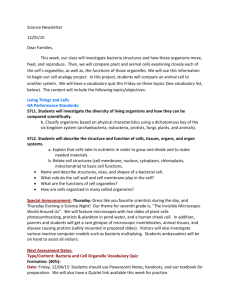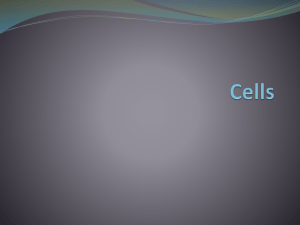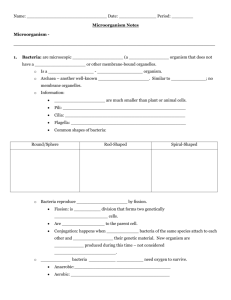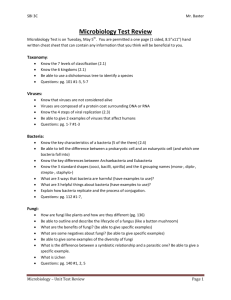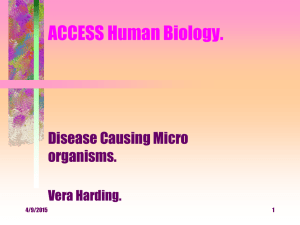Microbiology Notes: Causes of Disease - Ms. Dawkins
advertisement
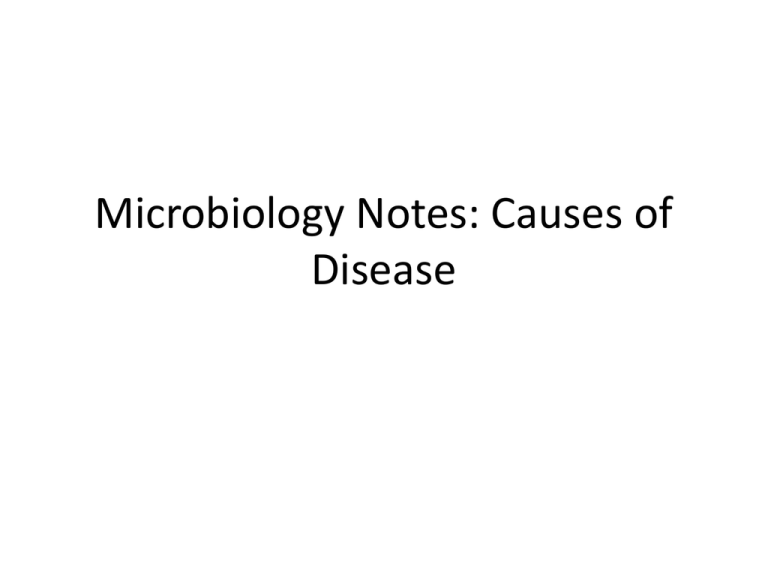
Microbiology Notes: Causes of Disease What is disease? • Disease is a change that disturbs the normal functioning of the body’s systems. • Many diseases are classified as infectious, or diseases that can be spread. – Caused by viruses, bacteria, and other pathogens • Pathogens: organisms that cause disease What is germ theory? • The germ theory describes some causes of disease. – In the 1800s, Pasteur did experiments that showed microorganisms (bacteria) caused milk to spoil. – Pasteur’s Germ Theory states that some diseases, called infectious diseases, are caused by germs. • Germs are the general name given to organisms that cause disease. What is microbiology? • Organisms come in many shapes and sizes. – microbiology: study of small living things • microorganisms: very small organisms – need microscope to see – organisms are classified into kingdoms • 6 kingdoms – archaea, bacteria, protists = microscopic/unicellular – animals, fungi, plants = multicellular What causes disease? • Disease can be caused by viruses, bacteria, fungi, protists, or parasites. What are viruses? • Viruses are non-living particles composed of a nucleic acid (DNA or RNA) and a protein coat. • Viruses need a host cell to reproduce—this is why they are not considered alive! – Host cell: the cell that a virus infects • Viruses invade healthy cells and use the enzymes and organelles of the host cell to make more viruses, usually killing the host cell in the process. Viruses (continued) • Viral diseases are among the most widespread illnesses in humans. These illnesses range from mild fevers to some forms of cancer and include several other severe and fatal diseases. • Transmission of these illnesses varies; some are transmitted by human contact, while others are transmitted through water or an insect bite. • Vaccines and some anti-viral drugs are used to control and prevent the spread of viral diseases. • Examples: cold, flu, HIV, polio, chickenpox, and many many more. What are bacteria? • Bacteria are everywhere. About 300 species of bacteria are living in your mouth. • Bacteria are prokaryotic single-celled organisms. • They can live in a variety of places (with oxygen, without oxygen, extreme hot, extreme cold). • Bacteria reproduce through binary fission, a form of asexual reproduction. Under optimal conditions, bacteria can grow and divide extremely rapidly, and bacterial populations can double very quickly. • Scientists classify bacteria by their external shapes. – Spiral-shaped: occur in single strands – Rod-shaped : may occur singly or in chains – Round-shaped: may occur singly, in pairs, chains, or clusters • Bacteria (cont.) Antibiotics are used to inhibit (slow/stop) the growth of bacteria. Because antibiotics have been overused, many diseases that were once easy to treat are becoming more difficult to treat. Antibiotic resistance in bacteria occurs when mutant bacteria survive an antibiotic treatment and give rise to a resistant population. • Examples: Strep throat, staph infections, pneumonia – Some bacteria, such as producers and decomposers are helpful to other organisms. • Some bacteria break down the matter in dead bodies and waste materials. • Ex: Bacteria are used to clean up oil spills by decomposing oil. • Bacteria can change materials that do not come from living things and make them available for other organisms. • Ex. Nitrogen fixation—changes nitrogen gas into a form plants can use What are fungi? • Fungi are eukaryotic, nonphotosynthetic organisms (they don’t go through photosynthesis, they have to eat food), and most are multicellular. • Most fungi reproduce both sexually and asexually (producing spores). This provides an adaptive advantage. When the environment is favorable, rapid asexual reproduction ensures an increased spread of the species. During environmental stress, sexual reproduction ensures genetic variation, increasing the likelihood that offspring will be better suited to the new environmental conditions. Fungi (cont.) • Fungi can sometimes attack the tissues of living plants and animals and cause disease. Fungal disease is a major concern for humans because fungi attack not only us but also our food sources, making fungi competitors with humans for nutrients. • Mold spores can cause mild to serious allergies in some people. Billions of mold spores can become airborne and may then be inhaled, triggering an allergic reaction. • Examples: black mold, fungal meningitis What are protists? • Protists are mostly single-celled, microscopic organisms mostly found in water. – Include multicellular organisms, but don’t belong to the other kingdoms. – Protists play many roles in their environment. • Some are producers that also produce oxygen which is beneficial to many other organisms. • Some protists act as parasites and can cause disease in many organisms, including humans. • Algae is a protist that uses sunlight as an energy source. Protists (cont.) • Protozoa are animal-like protists that eat other organisms or decaying parts of other organisms. – Many forms, all single-celled – Cannot use sunlight as an energy source – Must move around to obtain energy – Ex. Paramecium: Have cilia, which are short, wavy strands of “hair” – Some protozoa have flagella, which are whip-like “tails” used to swim. Ex: Euglena • Many protists live as parasites, some of which cause disease. • Malaria is one of the world’s most significant diseases, and is caused by a protist. A mosquito carries the parasite from human to human through blood. What are parasites? • A parasite is an organism that feeds on another individual, known as the host. They either live on or in their host’s body. • Parasites have evolved to efficiently feed off of the host’s body, so they are usually very specialized. Tapeworms are so specialized for a parasitic lifestyle that they do not even have a digestive system. They live in the small intestine of their host and absorb nutrients directly through their skin. • Infectious disease may also be caused by animal parasites, which may take up residence in the intestines, bloodstream, or tissues.

